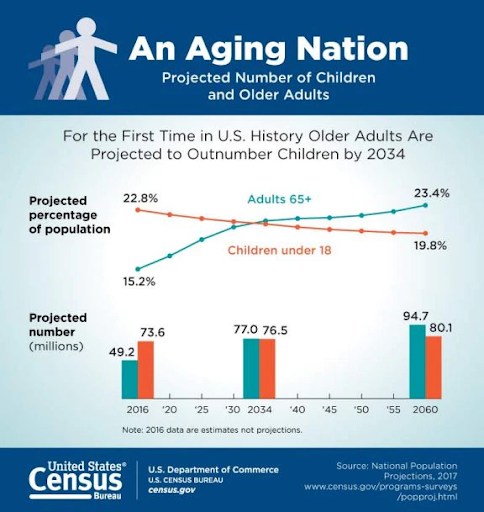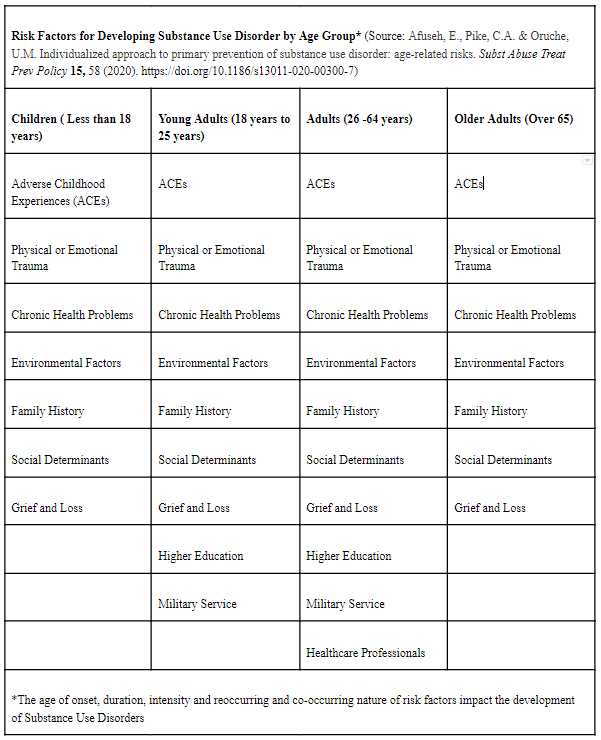Home > What’s Age Got to Do With It: Prevention Across the Lifespan
By Cecilia M. Fichter DeSando, MPM
As adults, many of the health issues that we encounter have their roots in our biology and experiences that occur throughout our life. Prevention programs that provide early education and timely interventions for individuals and populations at multiple stages throughout the lifespan provide what is known as a life-course approach of increasing protective factors and decreasing risk factors throughout people’s lives. A life-course approach aims to reduce health disparities, the incidence of disease, and premature death.
Knowledge of contextual and systemic dynamics related to prevention programs (e.g., gender, age, socioeconomic status, culture/race/ethnicity, sexual orientation, spirituality, religion, larger systems, and social context) and knowledge of Risk and Protective Factor Theory are listed among the Substance Abuse and Mental Health Service Administration’s (SAMHSA) Prevention Core Competencies designed to strengthen the field of substance use prevention, offer professional direction to the prevention field, and provide guidance for training programs and service delivery qualification.
Age-related Prevention
Most of the science, knowledge, experience and focus of prevention programming has been with children, youth, and young adults. Children and youth programming are extremely important as early interventions during vulnerable time periods have shown to have the ability to prevent substance use, increase healthy behaviors and change the trajectory of a life course in a positive direction. Some prevention programs have been found to even reduce substance use for future generations. Although substance misuse often declines after young adulthood, prevention cannot stop there. The National Institute on Drug Abuse (NIDA) reports that nearly 1 million adults 65 and older live with a substance use disorder (SUD). Recent research has highlighted an increase in marijuana use among middle-aged and older Americans. Prescription opioid misuse, heroin use, and suicidal thoughts are also increasing for this population. As the world’s older population grows, the need for age-related interventions grows as well. Demographic trends project that the older population will continue to grow and more attention will be needed in this area. According to the World Health Organization (WHO) and U.S. Department of Health and Human Services Report Global Health and Aging, the number of people in the world aged 65 or older is projected to grow from an estimated 524 million in 2010 to nearly 1.5 billion in 2050, with most of the increase in developing countries.
The U.S Census Bureau projects that by 2034 older adults will outnumber children for the first time in U.S. history. People age 65 and over are expected to number 77.0 million while children under age 18 will number 76.5 million.

Unequal Aging and a Life-Course Approach
Not all risk and protective factors for substance use end with the onset of adulthood and maturation. Many risk factors tend to have a cumulative effect on the development of behavioral health issues, non-communicable diseases, and premature death. Sociologist Corey Abramson, Ph.D. outlines this cumulative effect in his research on unequal aging. Racial and socioeconomic disparities in resources, healthcare, and networks are cumulative over a lifetime and do not end for older adults. “In other words, the inequalities that shape our opportunities from birth, also structure our final years. Advantages and disadvantages accumulate. The reality is later life is not the end game of inequality, it is inequality’s endgame.” To address this inequality, prevention programs and policies that address needs, disparities, social determinants, and other risk factors over a lifetime are recommended. Public health research highlights the need for a life-course approach to the prevention of disease and health disparities. A life-course approach addresses the needs of each age group at different stages and provides prevention and intervention at the earliest stage and continues throughout the lifespan. Prevention of SUDs using a life-course approach is both individual and population-based and requires identifying age-related risk factors, individualized assessment, and multiple strategies for designing age-appropriate resources, supports, and services.

Life-Course Prevention Strategies and Resources
Implementing age-appropriate prevention programming and screening across multiple communication channels and in multiple contexts or settings across the lifespan is an inclusive method for addressing individual and population-based risk factors in a timely manner to reduce disease and promote health for all age groups. Providing programming in schools, health care settings, workplaces, churches, and community and neighborhood locations increase the ability to reach different populations with age-specific messages. Multiple communication channels are necessary to reach different age groups and demographics. The Pew Research Center provides information on social media and smartphone usage patterns to assist with targeting messages and services to different age and demographic groups.


SAMHSA through its Evidenced-Based Practice Resource Center has products for all age groups. In addition, there are multimedia resources for young adults and a number of products for serving older adults with mental and substance use disorders that can be useful to clinicians, other service providers, older adults, and caregivers.
The National Institute on Drug Abuse (NIDA) provides validated screening tools for different populations and settings. It is organized by substance type, patient age, and administration method to help in selecting the right tool.
The Addiction Technology Transfer Center Network, the Prevention Technology Transfer Center Network, and their Regional Technology Transfer Centers have resources, training, and materials to assist in the development of prevention programming across the lifespan.
SUD prevention across the lifespan requires knowledge and understanding of developmental stages, age-related risk factors, and the cumulative effect of social determinants of health to implement multiple evidence-based strategies and interventions across multiple timeframes in multiple contexts and settings, using multiple age and population-based communication channels. What’s age got to do with it? Everything!
Author's Note
Cele Fichter-DeSando, MPM (She, Her) is a consultant and trainer in substance use and gambling prevention and tobacco prevention and control. Cele has a Master’s degree in Public Management from Carnegie Mellon University and more than 35 years of experience in the management, training, and implementation of research-based prevention programs in Pittsburgh Pennsylvania. In 2020, Cele started a certified woman-owned business, CFD Consulting LLC, and has provided consulting for numerous organizations including Tobacco-Free Allegheny, the PTTC Network, and the Danya Institute Central East ATTC. She is passionate about providing resources, materials, and practical applications for evidenced-based prevention programs and prevention science to prevention practitioners.
Cele Fichter-DeSando, MPM
CFD Consulting, LLC
[email protected]
412-580-3089
References
Abramson, Corey. (2016). Unequal Aging: Lessons From Inequality’s End Game. Public Policy & Aging Report. 26. 68-72. 10.1093/ppar/prw006.
Afuseh, E., Pike, C.A. & Oruche, U.M. Individualized approach to primary prevention of substance use disorder: age-related risks. Subst Abuse Treat Prev Policy 15, 58 (2020). https://doi.org/10.1186/s13011-020-00300-7
Jones, N. L., Gilman, S. E., Cheng, T. L., Drury, S. S., Hill, C. V., & Geronimus, A. T. (2019). Life Course Approaches to the Causes of Health Disparities. American journal of public health, 109(S1), S48–S55. https://doi.org/10.2105/AJPH.2018.304738
Mikkelsen B, Williams J, Rakovac I, Wickramasinghe K, Hennis A, Shin H et al. Life course approach to prevention and control of non-communicable diseases BMJ 2019; 364 :l257 doi:10.1136/bmj.l257
NIDA. 2019, July 10. Drug Use and Its Consequences Increase Among Middle-Aged and Older Adults. Retrieved from https://www.drugabuse.gov/news-events/nida-notes/2019/07/drug-use-its-consequences-increase-among-middle-aged-older-adults on 2021, September 2
NIDA. 2021, July 19. Preventive Interventions Delivered in Childhood May Reduce Substance Use Over Two Generations. Retrieved from Preventive Interventions Delivered in Childhood May Reduce Substance Use Over Two Generations on 2021, August 30
Pew Research Center April 7, 2021 Social Media Use in 2021 by Brooke Auxier and Monica Anderson accessed from https://www.pewresearch.org/internet/2021/04/07/social-media-use-in-2021/
Substance Abuse and Mental Health Services Administration: Prevention Core Competencies. Publication No. PEP20-03-08-001. Rockville, MD: Substance Abuse and Mental Health Services Administration, 2021.
Substance Abuse and Mental Health Services Administration: Risk and Protective Factors
https://www.samhsa.gov/sites/pttc/files/20190718-samhsa-risk-protective-factors.pdf
World Health Organization. The Minsk Declaration: the life course approach in the context of health 2020. WHO.2015;